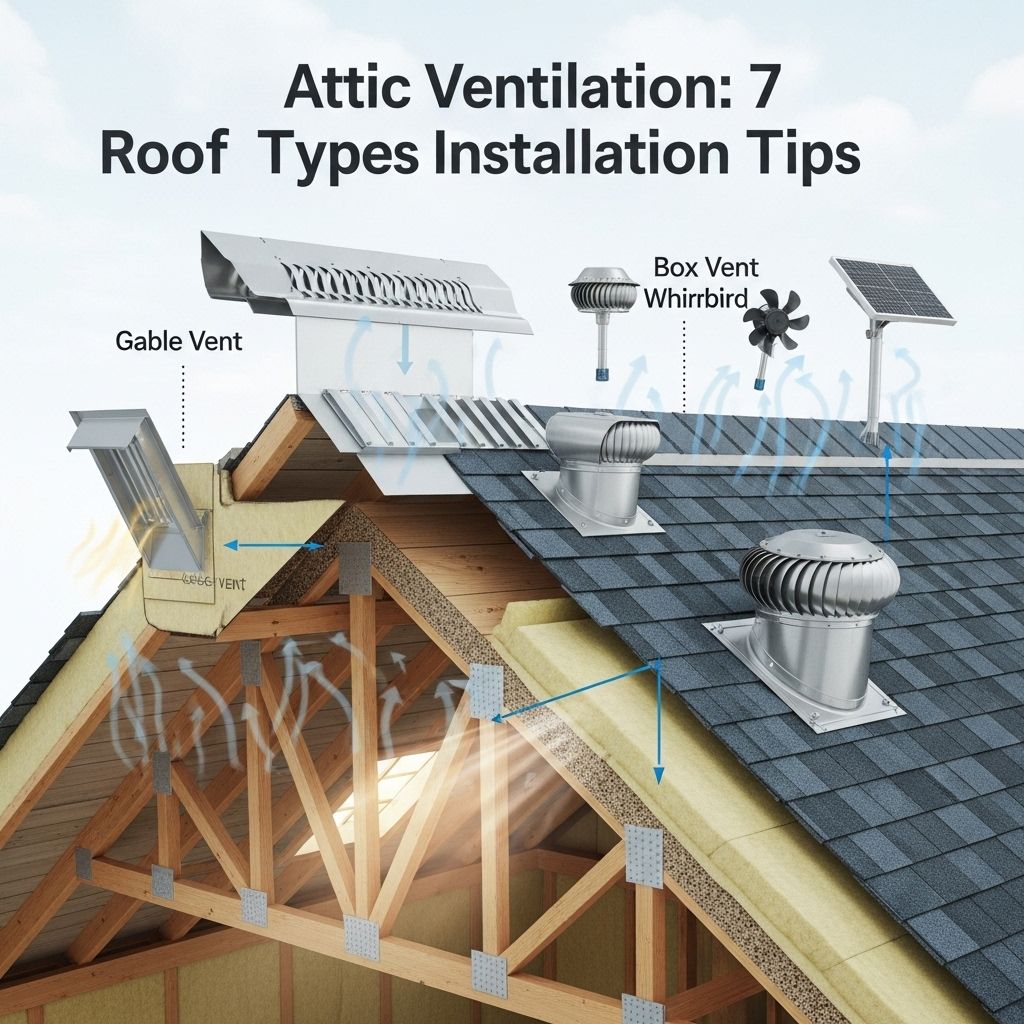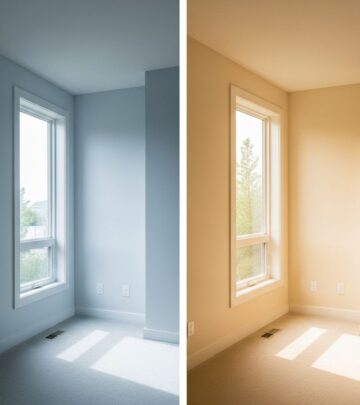Attic Ventilation: 7 Roof Vent Types And Installation Tips
Everything you need to know about roof ventilation for a healthier, longer-lasting home.

Image: HearthJunction Design Team
Roof Venting Basics: A Complete Guide for Homeowners
Proper roof ventilation is a cornerstone of home longevity, energy efficiency, and indoor comfort. Many homeowners underestimate the value of venting in the attic and roof areas, often leading to problems like mold, ice dams, and premature roof aging. This guide explores the essentials of roof venting—from types and functions to installation tips and frequently asked questions—to help you make informed decisions and protect your investment.
Why Roof Ventilation Matters
Roof ventilation is about more than just having a few vents in your roof; it’s a systematic approach to maintaining airflow and managing heat and moisture in your attic space. The dual purpose is to maximize comfort inside your home and extend the lifespan of your roofing materials.
- Prevents Moisture Buildup: Adequate venting minimizes condensation, which can otherwise lead to mold, mildew, and wood rot.
- Reduces Heat Accumulation: In hot months, it allows excessive heat to escape, reducing cooling costs and preventing shingle damage.
- Prevents Ice Dams: In winter, roof ventilation helps keep the roof cold, preventing snow from melting and refreezing at the eaves.
- Improves Indoor Comfort: Temperature swings in attics can affect the living spaces below, making your home less comfortable and increasing HVAC use.
How Roof Ventilation Works
Proper roof ventilation relies on a balance between “intake” and “exhaust.” Intake vents—usually located along the soffits or eaves—allow cool, fresh air into the attic. Exhaust vents—placed along or near the roof peak—let warm, moist air out. This continuous airflow creates a natural convection cycle that keeps your attic dry and temperate year-round.
Key Elements of Roof Ventilation:
- Intake Vents (Soffit or Eave Vents): Bring in cooler outside air.
- Exhaust Vents (Ridge, Gable, or Roof Vents): Let warm, stale air escape.
- Balanced System: Balanced intake and exhaust ensures efficient, even airflow—typically one square foot of vent area for every 300 square feet of attic floor space, split evenly between intake and exhaust.
Types of Roof Vents
There are several styles of roof vents, each with its own advantages, disadvantages, and best-use scenarios. Here’s a breakdown of the most common vent types found in residential roofs:
- Soffit Vents: Installed under the eaves; primary source of fresh air intake.
- Ridge Vents: Run along the roof peak for continuous exhaust; often paired with soffit vents for balanced systems.
- Gable Vents: Positioned on gable ends; supplement exhaust, though less effective at moving air evenly throughout the attic.
- Roof Louvers (Box Vents): Static vents installed near the ridge; simple, but may require multiple units for large attics.
- Turbine Vents: Spinning units that use wind power for enhanced air movement.
- Power Vents: Electrically or solar-powered fans for active air evacuation; best for hard-to-vent attics, but require wiring and maintenance.
- Cupola Vents: Ornamental yet functional structures, usually for venting in barns and similar outbuildings.
Comparison Table: Common Roof Vents
| Vent Type | Main Function | Location | Pros | Cons |
|---|---|---|---|---|
| Soffit | Intake | Under eaves | Continuous airflow, easy to install | Can be blocked by insulation |
| Ridge | Exhaust | Along roof peak | Low-profile, effective with soffit vents | Can be less effective without proper intake |
| Gable | Exhaust | Gable ends | Easy retrofit | Limited airflow control |
| Roof Louver | Exhaust | Near ridge | No moving parts | Multiple needed for large attics |
| Turbine | Exhaust | Near ridge | Powers itself with wind | Can be noisy or leak if damaged |
| Power | Exhaust | Attic or roof | Best for complex roofs | Requires electricity, potential for maintenance |
Signs of Poor Roof Ventilation
If you’re unsure about your current ventilation, watch for these warning signs. Addressing them early can save money and extend the life of your home:
- Excessive Heat in the Attic: Hard to cool upper floors in summer, even with AC running.
- Frost or Moisture Accumulation: Damp insulation, frost on rafters in winter, or visible mold/mildew growth.
- Peeling Paint or Blistering Shingles: Signs that excessive heat and moisture are trapped.
- Ice Dams at Eaves: Repeated ice build-up on the roof edge in winter.
- Musty Odors: Persistent smells indicating moisture issues.
Common Roof Ventilation Mistakes
Many well-intentioned homeowners and some professionals make common mistakes when it comes to attic venting. Avoid these pitfalls to ensure your investment works as intended:
- Blocking Soffit Vents with Insulation: Always use baffles to maintain airflow from the eaves.
- Unbalanced Systems: Too much exhaust without corresponding intake, or vice versa, disrupts effective airflow.
- Mixing Vent Types Incorrectly: For example, combining power vents with passive vents can short-circuit natural airflow, rendering the system ineffective.
- Poor Location of Vents: Intake and exhaust vents must be strategically placed for optimum movement—random placement leads to dead spots.
DIY Roof Ventilation Tips
While some ventilation projects require a professional, many homeowners take on minor upgrades themselves. Here are some pointers for safe and effective DIY roof venting:
- Calculate your venting needs: Use the 1:300 rule (one square foot of vent area per 300 square feet of attic space, split between intake and exhaust).
- Check local building codes to ensure compliance—requirements may vary based on climate and home design.
- Install soffit vents with insulation baffles to prevent blockage by attic insulation.
- Inspect existing vents annually and clear away leaves, nests, or debris.
- Ensure attic insulation doesn’t cover or block air pathways.
- Seal air leaks between the attic and living spaces to prevent moist indoor air from entering the attic.
Professional Roof Vent Installation
If your attic is difficult to access, your roof is unusually shaped, or you want to add powered ventilation, hiring a professional is often the safest and most effective path. They can also assess your home’s particular needs and recommend ideal solutions for maximizing efficiency and value.
- Professionals can install ridge, power, or turbine vents safely and correctly.
- Experts will ensure vents are weatherproofed and strategically located.
- Many pros offer attic inspection services to recommend ventilation improvements before major issues arise.
Roof Ventilation and Energy Efficiency
Good roof ventilation directly correlates with savings on heating and cooling bills. In summer, removing hot attic air lessens the burden on your HVAC system. In winter, it insulates against heat loss, minimizing the risk of ice dams and related roof damage.
- Reduced Cooling Costs: By venting superheated attic air, your AC works less, using less energy.
- Lower Heating Costs: Prevents ice dams and keeps insulation dry and effective.
- Prolonged Roof Life: Less moisture exposure and lower temperature fluctuations extend shingle and underlayment durability.
Climate Considerations
Optimal ventilation systems vary depending on regional climate. For instance, homes in hot, humid regions may need more extensive venting to manage moisture, while homes in cold areas must protect against ice dams without letting excessive outside air in. Consult local professionals for best-fit solutions.
Frequently Asked Questions (FAQs)
What is the main purpose of roof ventilation?
The primary goal is to regulate attic temperature and moisture, preventing damage and improving indoor comfort.
How do I know if my attic is properly ventilated?
Check for temperature extremes, moisture or mold, and consistent issues like ice dams or musty odors. These are red flags for poor ventilation.
Can I mix different types of roof vents?
Generally, it’s best to stick to one exhaust type (such as ridge vents or box vents) with soffit intake vents to maintain airflow balance and avoid disrupting the natural convective cycle.
What happens if attic vents are blocked?
Blocked vents trap heat and moisture, leading to mold, structural decay, and ice dams. Always keep vents clear and unobstructed, using baffles where needed.
Should I use powered attic fans?
Powered fans can help in complex roofs or where natural airflow isn’t enough, but they consume energy and must be installed correctly to avoid drawing conditioned air from your home.
Conclusion
Proper roof ventilation is critical for a healthy, energy-efficient home. By understanding the basics, selecting the right vent types, and ensuring balanced airflow, homeowners can prevent costly repairs, lower their energy bills, and maintain a comfortable indoor environment for years to come. If you’re unsure about your home’s ventilation needs, consult a professional for a thorough attic assessment and tailored recommendations.
Read full bio of Anjali Sayee










